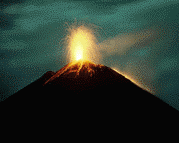Evidence of our Pre-historic Atmosphere
The very hot surface of the Earth during the early period of enormous impacts meant
gases, particularly CO2, locked up in the rock can escape via
out-gassing in volcanos and lava flows. These impacts also deposited enormous
volumes of gas, and possibly water from the enumerable, early comet impacts.

Characteristics of our Pre-Historic Atmosphere
Geologists and Scientists have come up with very clever ways to tell us about
our atmosphere 3 b.y.a, using radio-active isotopes. But first, a few definitions!
Atoms are made up of Protons and Neutrons in the nucleus, with Electrons buzzing in orbits above the nucleus. Other important points:
 A neutral atom has equal numbers of protons and electrons.
A neutral atom has equal numbers of protons and electrons.  The number of protons determines the element (chemical), for ex., 6 protons = Carbon,
26 protons = Iron.
The number of protons determines the element (chemical), for ex., 6 protons = Carbon,
26 protons = Iron.  The atomic NUMBER of an atom is the #protons.
The atomic NUMBER of an atom is the #protons.  The atomic WEIGHT of an atom is the #protons + #neutrons.
The atomic WEIGHT of an atom is the #protons + #neutrons.  Neutrons are needed to hold the protons together (recall, they have like positive charges!).
Neutrons are needed to hold the protons together (recall, they have like positive charges!). The number of neutrons can vary from one atom of an element to the next. These different forms of
a particular element are called isotopes
The number of neutrons can vary from one atom of an element to the next. These different forms of
a particular element are called isotopes
Now try this quiz!
1) What do 40Ar (Argon-40) and 36Ar have in common? What is different about these two isotopes?
2) What do 40Ar and 40K (Potassium-40) have in common? What is different about these two elements?